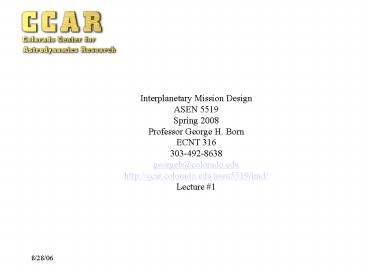Interplanetary Mission Design - PowerPoint PPT Presentation
1 / 23
Title:
Interplanetary Mission Design
Description:
XYZ is nonrotating, with zero acceleration; an ... Solution of ur Equations of Motion ... Velocity at aphelion, Velocity at perihelion, where. days. 8/28/06 ... – PowerPoint PPT presentation
Number of Views:119
Avg rating:3.0/5.0
Title: Interplanetary Mission Design
1
Interplanetary Mission Design ASEN 5519 Spring
2008 Professor George H. Born ECNT
316 303-492-8638 georgeb_at_colorado.edu http//ccar.
colorado.edu/asen5519/imd/ Lecture 1
2
Problem of Two Bodies
µ M1 M2
XYZ is nonrotating, with zero acceleration an
inertial reference frame
3
Equations of Motion in the Orbit Plane
The u? component yields
which is simply h constant
4
Solution of ur Equations of Motion
- The solution of the ur equation is (as function
of ? instead of t)
where e and ? are constants of integration.
5
Types of Orbital Motion
6
The Orbit and Time
- If angle f is known, r can be determined from
conic equation - Time is preferred independent variable instead of
f - Introduce E, eccentric anomaly related to time
t by Keplers Equation - E e sin E M n (t tp)
- where M is mean anomaly
7
Properties of Hyperbolic Orbits
asemimajor axis bsemiminor axis bangle of the
asymptote
8
n-Body Problem
- Assume that we have a s/c denoted as m2 whose
motion relative to m1 we wish to describe. Assume
that the motion of m2 is perturbed by mj, other
masses (planets) where
j3n
mj
r1j
From Newtons Law of Gravitation
m1
r1j
Gm1mj
r1j3
r2j
m1
r12
Z
r12
r1
Gm1m2
rj
r2j
r123
Gm2mj
m2
r2
r2j3
r12
O
- Gm1m2
Y
r123
X
inertial frame
m2
9
n-Body Problem
From Newtons Second Law
so
Note that we must have and to solve
this equation. We may solve for by numerical
integration or by using a planetary ephemeris
file. Then
j3.n
10
n-Body Problem
Notice that the n-body problem has 6 degrees of
freedom for each body or 6n total
degrees of freedom.
Hence, 6n constants of the motion are
required for a solution to the equations of
motion.
These constants are
n
Degrees of Freedom
Linear Momentum (CM)
Total Angular Momentum
Total Energy
vector
eliminates one component of the e-vector
Total Integrals of Motion (consts)
Jacobi constant included
velocity of c.g. is constant 6 consts are
11
n-Body Problem
- Where
- Recall that , but
since there are no external forces, is
a constant.
The table on the previous slide is from Jeff
Parkers dissertation
12
n-Body Problem
- The total energy of the system is given by
- The total work done by the external forces is
equal to the change in total energy of the
system. Because there are no external forces,
total energy is conserved.
13
Julian Day
- Calculation of the Julian Day No. at 0h UT Ref.
(Curtis p214). Julian day is a continuous count
from the year 4713 BC and begins at 12h UT, i.e.,
Greenwich mean noon. - Where Y, M, D lie in the following range
INT integer
14
Julian Day
- At any other UT the Julian Day is given by
- where
- Example What is the Julian Day Number for Oct.
4, 1957 UT 192624 (The launch date of
Sputnick I)?
Jo Julian Day Number at 0 hr UT
15
Julian Day
days
16
Patch Conics
- The Patch Conic divides the planetary mission
into three phases - The Departure Phase Bodies are the Earth and
S/C, the trajectory is a departure hyperbola with
the Earth at the focus. Influence of the Sun and
Target Planet are neglected. - Cruise Phase Bodies are the Sun and S/C and the
trajectory is a transfer ellipse with the Sun as
the focus. Planets are neglected. - Arrival Phase Bodies are target planet and S/C.
The trajectory is an arrival hyperbola with the
Planet at the focus. Sun and Earth are
neglected.
17
Patch Conics
- Phases begin and end at the sphere of influence
(SOI). In reality, the SOI often is neglected
since the effect is small. For the Earth, the
true anomaly on the transfer ellipse should be
reduced by 0.15 to account for the Earths SOI.
18
Patch Conics
- Example Consider an Interplanetary mission from
Earth to Venus. - Assumptions
- 1) Planetary orbits are circular and coplaner.
- 2) Transfer ellipse is tangent to Earth Venus
orbit i.e. and transfer is a simple
Hohmann ellipse
Venus _at_ arrival
Earth _at_ launch
r?
?
?
?
19
Patch Conics
- The transfer orbit elements are easily
calculated
?
?
20
Patch Conics
Transfer orbit elements contd Velocity at
aphelion, Velocity at perihelion,
, where
days
?
21
Patch Conics
at departure on transfer ellipse
Hence, we must slow the heliocentric velocity of
the s/c
22
Patch Conics
Normally we refer to the energy required from the
launch system as
at Venus, the target planet
?
23
Patch Conics
- To capture the s/c at Venus we must supply a ?V
to - reduce velocity.
- Could choose an rp, compute the energy
- from , then compute periapsis velocity
and - circular velocity of capture orbit.
- This gives ?V needed for capture.





























![History of the IEEE Aerospace and Electronic Systems Society Moshe Kam, Drexel University [for Eric Herz] PowerPoint PPT Presentation](https://s3.amazonaws.com/images.powershow.com/7685585.th0.jpg?_=202012101110)

